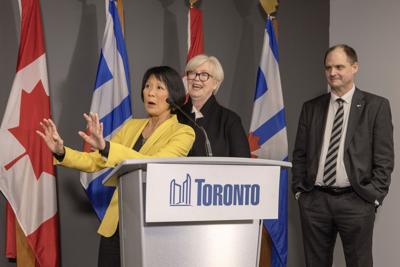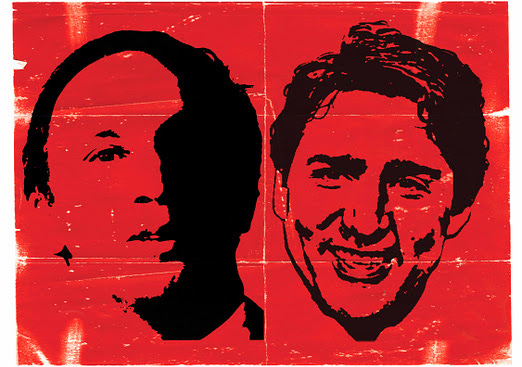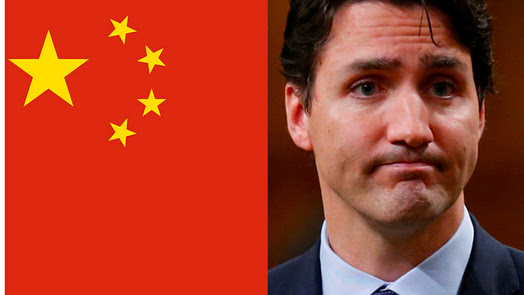FIRST READING: Ottawa could fix housing if it felt like it. They did it before
In the 1970s, Canada decisively tamed a housing shortage via low immigration and an explosion in home-building Author of the article: Tristin Hopper Published Aug 14, 2023 • Last updated 4 days ago • 9 minute read 370 Comments  Newly minted housing minister Sean Fraser, who recently said he will be increasing housing affordability without bringing down real estate prices. The sentences are mutually exclusive. Photo by Justin Tang/The Canadian Press
Newly minted housing minister Sean Fraser, who recently said he will be increasing housing affordability without bringing down real estate prices. The sentences are mutually exclusive. Photo by Justin Tang/The Canadian Press
TOP STORY
Read the conversation Have your say Leave a comment and share your thoughts with our community. Read All 370 Comments
This may be the month that the Trudeau government officially dropped all pretence of caring about fixing the housing crisis.
The Liberals strode into office in 2015 with promises of unlocking home ownership for the middle class. Instead, housing prices under their tenure have nearly doubled, and even in Canada’s mid-sized cities, home ownership is increasingly out of reach for anyone on a median salary.
And just this week, newly minted housing minister Sean Fraser effectively told Canadians to accept these numbers as the new normal. Whatever tack Ottawa is going to take on housing, they will be ensuring that prices stay high. “Our goal is not to decrease the value of their home,” Fraser told Bloomberg News.
But there was a time when Ottawa could look upon a country critically short of homes, and respond not with finger-pointing, but with an all-out construction boom the likes of which Canada had never seen. Affordability surged, rents dropped and analysts soon began to boast that Canadians were “now among the best housed people in the world.”
The prime minister during this long-lost golden age in affordable housing also happened to be named Trudeau. Tragically for the two-thirds of young Canadians who have now officially given up on owning a home like their parents, there’s no real reason Trudeau’s son couldn’t have done much the same thing.
In 1974 — the same year that Pierre Trudeau won a shattering re-election victory — the number of new homes built across Canada reached a level that they’ve never since exceeded. In that year, builders put the finishing touches on 257,243 new Canadian homes.
By comparison, over the last 10 years Canada has averaged just 197,000 annual housing completions — 76 per cent of the 1974 peak.
The contrast is all the more remarkable given that there were only 22.8 million people living in Canada in the mid-1970s. In 1974, one in every 100 Canadians could have purchased a brand-new home, and there still would been several thousand to spare.
And this rate of feverish home-building kept up for quite some time. For the entire 1970s, an average of 229,113 homes were built every single year. In the 43 years since, the 200,000 mark has been cracked only a handful of times.
What’s more, the 1970s were also relatively low-immigration years for Canada. There wasn’t a single year of Pierre Trudeau’s 15-year premiership in which the number of new immigrants was higher than the number of new homes. In 1978, Canada completed 246,533 homes and welcomed just 86,300 new immigrants.
None of the 1970s property boom was by accident. The sheer volume of new homes hitting the market was the end result of a federal government that openly vowed to put its middle and working classes into respectable accommodation — and actually meant it.
“We must … not only improve the operation of private markets in order to accelerate the total output of housing but we must also stimulate the provision of modest accommodation for low-income people,” Liberal MP Robert Andras — a perennial Pierre Trudeau cabinet member — declared in 1969.
Poverty had been on the upswing throughout the 1960s, and the solution pitched by the Liberal government was to throw up whole cities of new homes practically overnight, so that these growing ranks of Canadian poor would at least have a place to live.
In the 1970s, the housing-assistance activities of the Canadian Mortgage and Housing Corporation “exploded,” according to one history of the era.
A latticework of loan guarantees, tax credits and direct subsidies emerged to put millions of Canadians within reach of home ownership, and the construction market roared into high gear to meet the new demand.
Meanwhile, the Canada Rental Supply Program extended interest-free loans to developers who built social housing, and a firehose of federal monies was directed at subsidized housing projects.
“In the heyday of Canadian social housing from 1965 to 1990, 10 percent of total housing production was non-profit, public or co-operative,” wrote housing analyst Greg Suttor in a 2017 profile of this period.
That was enough affordable homes to “house half the lowest-income segment of the roughly 170,000 households added in Canada each year,” noted Suttor.
And rather than city cores increasingly becoming conclaves of the rich, the 1970s saw a flourishing of low-income options opening up “in the same neighbourhoods as middle-class Canadians lived in.”
When the Canadian government spoke of housing policy in the 1980s, it was framed as an unvarnished national triumph that stood as an example to the world.
“We have tripled our housing stock and rehabilitated the best of our older dwellings. Canadians are now among the best housed people in the world,” read a 1987 report issued by then housing minister Stewart McInnes.
It was basically the polar opposite of the situation now. The yearly output of new Canadian homes has now been stagnant for at least 20 years. In 2002, housing completions stood at 185,626. In 2019, the last full year before the COVID-19 pandemic, they stood at a near-identical 187,177.
At the same time, the number of Canadians needing homes is reaching meteoric highs. In 2022 alone, Canada registered one million new immigrants against 219,942 new home completions.
It’s now been a full 24 years since Canada has come close to marking a year that, like the 1970s, saw the number of new homes outpace the number of new immigrants.
A recent TD report forecast that if these trends continue, Canada’s housing shortfall will grow by another 500,000 units in just two years. “Greater thought and estimation needs to occur on what’s a true absorption rate for population growth,” cautioned the writers.
The cause of the Canadian housing affordability crisis has always been pretty simple: There are too few homes.
There are ways to tweak this by banning foreign investment or raising interest rates. But if immigration is going to stay at historic highs (and the Trudeau government has indicated that it might climb even higher); home prices aren’t going to be returning anywhere near normalcy until Canada can start building way more homes, way faster.
Even before recent immigration spikes, Canada already had the greatest structural housing deficit in the G7. According to a Scotiabank estimate from 2021, it would require an extra 1.8 million homes just to reach an affordability rate on par with the rest of the G7.
At current home building rates, even if the Canadian population stayed put it would take nine years just to make up the gap.
There’s no real reason that Canada couldn’t pull out all the stops to re-enact the 1970s building boom — although there are a few major barriers in the way.
For one, much of the low-hanging fruit is gone.
Nowadays, any significant expansion of the Canadian housing stock would likely require a fair bit of “intensification”: Turning single-family homes into four-plexes, building apartment buildings in the suburbs and remaking infrastructure to handle denser cityscapes. But in the 1970s, even in Canada’s largest cities, expanding the housing supply was usually just a matter of greenlighting some more subdivisions.
In 1977 Vancouver, single-family homes were so plentiful that it was still possible to buy one for the modern equivalent of only $375,000. In Toronto, when the 56-storey TD Bank Tower first opened in the middle of the city’s financial district in 1967, the city’s density was so low that its next-door neighbour was a surface-level parking lot.
“We can’t easily sprawl our way out of this,” said Steve Lafleur, a public policy analyst who writes often on the subject of housing affordability. Fifty years ago, builders could still “plop down a subdivision a 20-minute drive from the heart of the national economy,” said Lafleur.
But if there’s one glaring roadblock preventing Canada from pursuing a second all-out building boom, it’s the fact that today’s municipalities are way more obstinate than their 1970s predecessors. Restrictive zoning laws and other thickets of municipal red tape have largely kneecapped any ability of developers to build with the feverish intensity of the 1970s.
In the 1970s, said Lafleur, “the feds were serious about expanding affordable rental options and the municipalities didn’t really get in the way.”
Cities didn’t get in the way of any new development, really. “The image of rapid growth in … major urban centres was widely accepted in the late 1960s and early 1970s,” read a 1975 report by the Science Council of Canada. Vancouver in the late 1960s and early 1970s was so uncompromisingly pro-development that there exist images of its mayor riding a wrecking ball.
The federal government of 2023 is again willing to drop billions on affordable housing, albeit at much lower rates than the Pierre Trudeau government. But even that “won’t move the needle because municipalities aren’t willing to accommodate enough growth,” said Lafleur.
Nowadays, whenever the feds greenlight a new package of demand-side measures to put more money into the housing market, it doesn’t spur construction — it mostly just bids up prices even worse.
The easiest way out of this impasse is simply to steamroll municipal power, and there have indeed been recent moves in that direction. B.C. and Ontario have both introduced legislation that would essentially ban cities from restricting lots to single-family homes.
And Conservative Leader Pierre Poilievre is now pitching a housing program that would shut off federal money to cities that doesn’t meet federal homebuilding targets: In essence, defunding any city council with overly NIMBYist tendencies.
In 1974, Canada built an average of 704 new homes every single day. Notably, that’s almost exactly the same number by which the current housing shortage is getting worse. If TD’s estimates of a 500,000-unit shortfall over the next two years hold true, that’s another 685 units added to the shortfall each day.
Whatever’s going to fix this, it will need to be big. As for the measures now being pitched to increase densification: “It’s too little, too late,” said Lafleur.





 Newly minted housing minister Sean Fraser, who recently said he will be increasing housing affordability without bringing down real estate prices. The sentences are mutually exclusive. Photo by Justin Tang/The Canadian Press
Newly minted housing minister Sean Fraser, who recently said he will be increasing housing affordability without bringing down real estate prices. The sentences are mutually exclusive. Photo by Justin Tang/The Canadian Press



 FILE: Conservative foreign-affairs critic Michael Chong rises during Question Period in the House of Commons on Parliament Hill in Ottawa on Monday, Feb. 13, 2023. Photo by THE CANADIAN PRESS/ Patrick Doyle
FILE: Conservative foreign-affairs critic Michael Chong rises during Question Period in the House of Commons on Parliament Hill in Ottawa on Monday, Feb. 13, 2023. Photo by THE CANADIAN PRESS/ Patrick Doyle